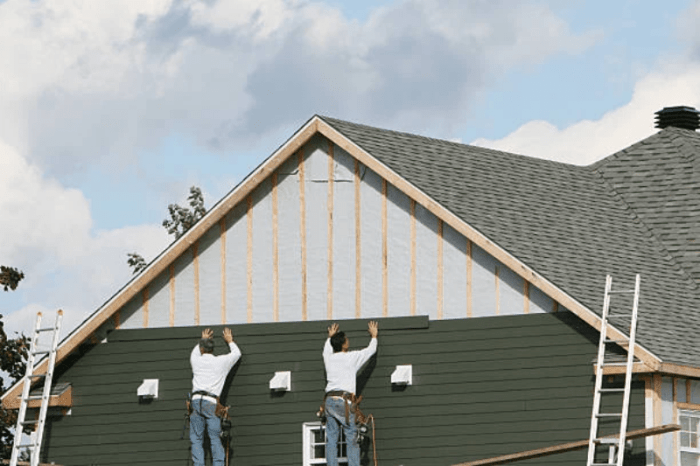Fixing Aluminum Siding: A Comprehensive Guide
Embark on a journey to discover the ins and outs of fixing aluminum siding. From common issues faced by homeowners to the essential tools and techniques required, this guide will equip you with the knowledge needed to maintain and repair your home's siding effectively.
Delve deeper into the world of aluminum siding repair as we explore the intricate details of preparing for repairs, different repair techniques, and the finishing touches that will elevate the look and durability of your home.
Introduction to Fixing Aluminum Siding
Aluminum siding is a popular choice for many homeowners due to its durability and low maintenance. However, like any exterior material, aluminum siding can face issues over time that may require fixing.
Common issues that homeowners face with aluminum siding include dents, scratches, fading, and corrosion. These issues can not only affect the appearance of your home but also impact the overall protection it provides against the elements.
Importance of Maintaining Aluminum Siding
Proper maintenance of aluminum siding is essential to ensure its longevity and functionality. Regular cleaning, inspection, and repairs can help prevent more significant issues down the line, saving you time and money in the long run.
Why Fixing Aluminum Siding is Crucial
Fixing aluminum siding is crucial for maintaining the curb appeal of your home and preserving its structural integrity. Small repairs, such as fixing dents or scratches, can prevent further damage and prolong the lifespan of your siding, ultimately enhancing the overall look and durability of your home.
Tools and Materials Needed

When it comes to fixing aluminum siding, having the right tools and materials is essential to ensure a successful repair job. Here is a list of the essential items you will need:
Essential Tools:
- Caulk gun
- Utility knife
- Tin snips
- Hammer
- Drill with screwdriver bit
- Ladder
- Tape measure
- Gloves
Specific Materials for Different Types of Siding Damage:
- Small Holes and Cracks:Aluminum patching compound, putty knife
- Large Holes:Aluminum flashing, J-channel
- Dented Areas:Rubber mallet, wood block
Safety Equipment:
- Safety goggles
- Dust mask
- Gloves
- Work boots
Preparing for Repair
When fixing aluminum siding, it is crucial to prepare the work area properly to ensure a successful repair job. This involves safely removing damaged siding and inspecting the underlying structure for any additional damage.
Removing Damaged Siding
To safely remove damaged aluminum siding, follow these steps:
- Start by carefully prying off the damaged siding using a pry bar or a special siding removal tool. Be gentle to avoid causing further damage.
- Once the damaged piece is removed, clean the area underneath to remove any debris or dirt that may have accumulated.
- Inspect the exposed area for signs of water damage or rot, as this may indicate a more serious issue that needs to be addressed before installing new siding.
Inspecting the Underlying Structure
After removing the damaged siding, it is important to inspect the underlying structure for any additional damage. Here's how you can do it:
- Check for signs of water infiltration, such as mold, mildew, or discoloration on the wood framing.
- Use a screwdriver to gently probe the wood framing for soft spots or rot. Pay special attention to areas near windows, doors, and corners where water damage is more likely to occur.
- If you notice any structural damage, consult a professional contractor to assess the extent of the damage and recommend the necessary repairs.
Repair Techniques

When it comes to fixing aluminum siding, there are various repair techniques that can be employed to address different types of damage. From dents and scratches to damaged panels, each issue requires a specific approach to ensure a successful repair.
Fixing Dents in Aluminum Siding
- Assess the extent of the dent to determine if it can be repaired using a DIY approach or if professional help is needed.
- For small dents, use a rubber mallet or plunger to gently push the dent out from the inside of the siding.
- For larger dents, consider using a heat gun to carefully heat the area and then use a block of dry ice to cool it rapidly, causing the metal to contract and pop the dent out.
Repairing Scratches and Gouges
- Clean the scratched area thoroughly to remove any dirt or debris that may interfere with the repair process.
- Apply a primer specifically designed for aluminum surfaces to the scratched area to ensure proper adhesion of the touch-up paint.
- Use a touch-up paint that matches the color of your siding to fill in the scratch or gouge, applying it in thin layers until the damaged area is completely covered.
Replacing Damaged Aluminum Siding Panels
- Measure the dimensions of the damaged panel accurately to ensure that the replacement panel fits properly.
- Use a zip tool to unlock the neighboring panels and carefully remove the damaged panel without causing further damage to the surrounding siding.
- Install the new panel by sliding it into place and securing it with nails or screws, making sure it is flush with the existing siding for a seamless finish.
Painting and Finishing
When it comes to painting aluminum siding after repairs, there are certain best practices to follow to ensure a smooth and long-lasting finish. It's essential to match the paint color with the existing siding and maintain a consistent finish across the repaired areas to achieve a seamless look.
Matching Paint Color
To match the paint color with the existing siding, it's recommended to take a small sample of the siding to a paint store for color matching. They can use a spectrophotometer to analyze the color and provide you with the closest match.
It's crucial to ensure that the paint color matches perfectly to avoid any noticeable differences after painting.
Maintaining a Consistent Finish
To maintain a consistent finish across the repaired areas, make sure to clean the siding thoroughly before painting. Remove any dirt, grime, or loose paint to create a smooth surface for the new paint. Use a high-quality primer specifically designed for aluminum surfaces to ensure proper adhesion and durability.
Apply the paint evenly with a brush or roller, following the manufacturer's instructions for drying times and recoating. Inspect the finished areas to ensure a uniform finish and touch up any imperfections as needed.
Epilogue
As we conclude our discussion on fixing aluminum siding, remember that regular maintenance and timely repairs can significantly enhance the overall appearance and longevity of your home. By following the tips and techniques Artikeld in this guide, you'll be well-equipped to tackle any aluminum siding issues that come your way.
FAQ Resource
What are the common issues homeowners face with aluminum siding?
Common issues include dents, scratches, and damaged panels due to weather or age.
What tools are essential for fixing aluminum siding?
Essential tools include a hammer, nails, tin snips, and a pry bar.
How can I match the paint color when painting aluminum siding?
To match paint color, take a sample of the existing siding to a hardware store for color matching.
Why is it important to inspect the underlying structure before repairing siding?
Inspecting the structure helps identify any additional damage that may need to be addressed to prevent future issues.




